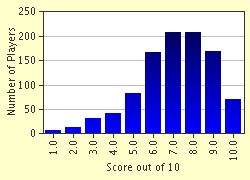Quiz Answer Key and Fun Facts
1. A quote by José Marti became also the name of a longdrink with rum, cola and lemon juice. What was this quote?
2. The Japanese Emperor is entitled "Tenno" in Japan. However, the honorary title that is used by foreigners is another word, meaning "Honourable Gateway". This Japanese word was also given to a cocktail with cognac, crème de curaçao and crème de noyaux. What is this cocktail?
3. A longdrink with vodka and orange juice has been named after the first Russian satellite, launched October 4th, 1957. What was the name of this satellite and of this longdrink?
4. A dessert with strawberries, vanilla ice, peach and chocolate ice has been named after the traditional pants that the original inhabitants of New York used to wear. What is the name of this type of pants?
5. A famous recipe with lobster is named after a month of the French Revolutionary calendar. Which month gave its name to this lobster recipe?
6. A sauce made of butter, flour, milk and mashed tomatoes, was named after the Roman goddess of dawn. Who was this goddess?
7. A recipe with chicken, tomatoes, garlic, olive oil and (according to some sources) crayfish was named after a battle Napoleon won. The French cooks would have found these ingredients on the battlefield and invented this recipe. Where did this battle take place?
8. The Belgian cheese factory Belgomilk produces a cheese named after a village that became famous in World War I. The Belgian brewer Duvel also started producing a beer with the same name in June 2000. However, the production of the beer stopped at the end of 2004.
The village I refer to was the centre of a battle fought between the allied (especially British) and German troops from July 31st, 1917 till November 8th, 1917. Which village was the centre of this battle that cost so many lives? As the orthography of most of these villages has changed since World War I, I have given the older spellings in brackets.
9. A famous French wine reminds us of the period of the "Babylonian Exile" of the Popes. Between 1309 and 1377, the Popes did not reside in Rome, because they feared the intervention of the Holy Roman Emperor (whose domains included large areas of Italy). Which wine does remind us of this "Babylonian Exile"?
10. According to some, a type of bread in the shape of a capital letter C was invented in Vienna in 1683, to celebrate the failure of the Turkish army to overtake the city. It is said that the Turks dug a tunnel under the walls of Vienna. As the tunnel surfaced in a bakery, the bakers alerted the citizens and prevented the Turkish soldiers from entering the city. What is the name of this type of bread?
Source: Author
JanIQ
This quiz was reviewed by FunTrivia editor
bloomsby before going online.
Any errors found in FunTrivia content are routinely corrected through our feedback system.

